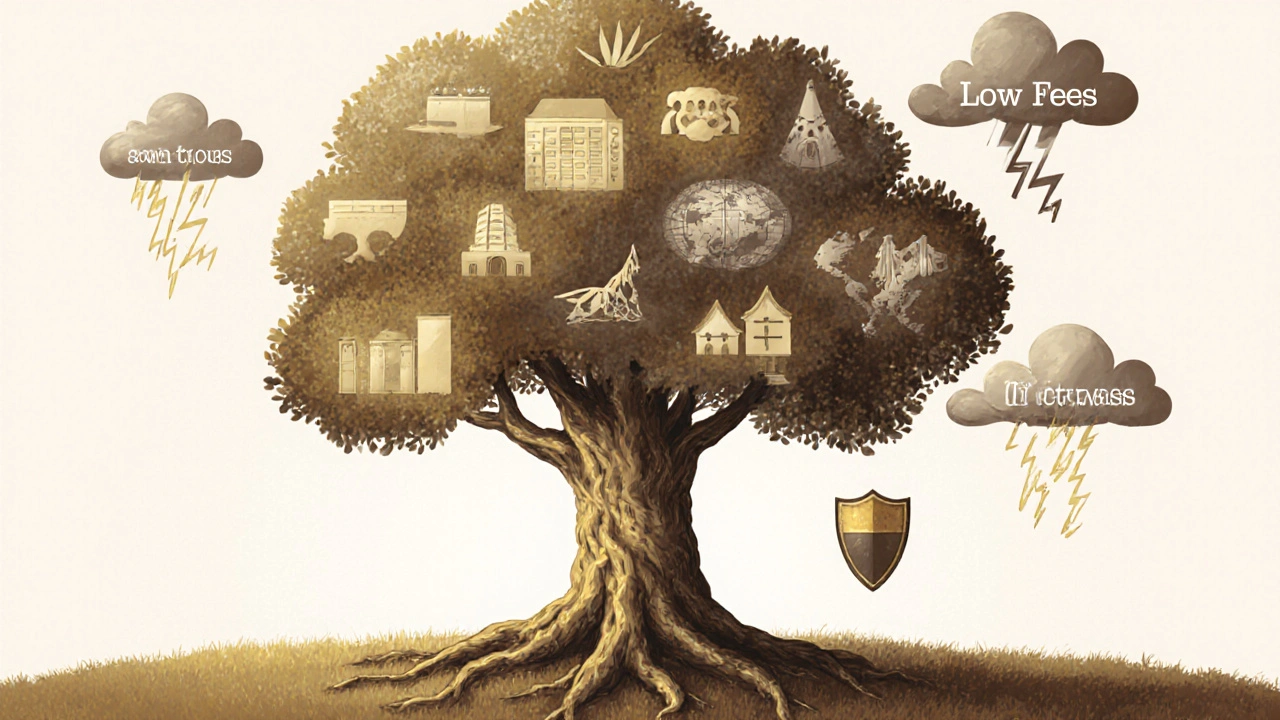Most people think stock trading is about picking the next big winner-some hot tip, a viral meme stock, or a flashy chart pattern. But the real secret to a successful investment portfolio isn’t about timing the market or chasing hype. It’s about consistency, discipline, and understanding what actually moves the needle over time.
What Makes a Portfolio Successful?
A successful portfolio doesn’t need to make 100% returns in a year. It just needs to grow steadily, survive downturns, and outpace inflation. The average S&P 500 investor from 1990 to 2024 made about 9.5% annually. But the average individual trader? Closer to 4%. Why? Because most people buy high and sell low-often without even realizing it.
Successful portfolios share three traits: diversification, low costs, and emotional control. You don’t need to be a genius. You just need to avoid the common mistakes everyone else makes.
Stop Trying to Beat the Market
Every year, fund managers, analysts, and YouTube gurus claim they’ve cracked the code. They predict which stocks will rise next week, which sectors will explode, or which AI startup will become the next Apple. The truth? Even professional investors with billions in assets and teams of analysts can’t consistently beat the market.
According to the SPIVA U.S. Scorecard (2024), 78% of actively managed U.S. large-cap funds underperformed the S&P 500 over a 15-year period. That’s not a fluke. It’s the math. Markets are efficient because millions of trades happen every second, pricing in news, earnings, and expectations almost instantly.
Instead of trying to pick winners, focus on owning the whole market. Index funds and ETFs like SPY or VTI give you exposure to hundreds or thousands of companies for under 0.1% in fees. You’re not betting on one company. You’re betting on the economy-and that’s a much safer bet.
Diversification Isn’t Just a Buzzword
Putting all your money in Tesla or Apple sounds exciting-until the stock drops 40%. That’s what happened to many investors in 2022. Tech stocks, once seen as invincible, lost trillions in value. If you had 80% of your portfolio in just five tech names, you didn’t just lose money-you lost confidence.
True diversification means spreading your money across:
- Stocks and bonds
- Domestic and international markets
- Large-cap, mid-cap, and small-cap companies
- Different industries (healthcare, energy, consumer goods, finance)
Even within stocks, don’t just pick what’s trending. Look at sectors that perform well in different economic conditions. For example, utilities and consumer staples hold up during recessions. Tech and industrials do better during growth periods. A balanced mix smooths out the ride.

Costs Are the Silent Killer
Every time you trade, you pay. Brokerage fees, bid-ask spreads, mutual fund expense ratios, advisory fees-these add up faster than you think.
Let’s say you invest $10,000 and pay 1% in annual fees. Over 30 years, with an average 7% return, you’d end up with about $69,000. Now, cut that fee to 0.2%. You’d have $92,000. That’s $23,000 extra-just by choosing lower-cost funds.
Use commission-free brokers. Stick to ETFs with expense ratios under 0.15%. Avoid actively managed funds unless you have proof they’ve beaten the market for 10+ years (and most haven’t). Your portfolio doesn’t need a fancy advisor. It needs to keep more of your money.
Emotions Are Your Worst Enemy
The biggest threat to your portfolio isn’t a recession, inflation, or a market crash. It’s you.
When the market drops 10%, 20%, or even 30%, your brain screams: “Sell now!” That’s the fear response. When it spikes 20% in a week, your brain says: “Buy more!” That’s greed.
Here’s what actually works: set a plan and stick to it. Decide in advance how much you’ll invest each month, what assets you’ll hold, and when you’ll rebalance. Then automate it. Set up automatic contributions to your brokerage account. Let the money flow in whether the market is up or down.
This is called dollar-cost averaging. You buy more shares when prices are low, fewer when they’re high. Over time, your average cost per share drops. And you avoid the trap of trying to time the market-which almost no one can do successfully.
Rebalance Once a Year
Markets move. Your portfolio drifts. If you started with 60% stocks and 40% bonds, a strong stock year might shift that to 75% stocks and 25% bonds. That’s riskier than you planned.
Rebalancing brings you back to your target. Do it once a year. Sell some of what’s grown too much. Buy more of what’s fallen. It’s counterintuitive-you’re selling high and buying low. But that’s exactly how you lock in gains and reduce risk.
Most people never rebalance. They just watch their portfolio change and hope for the best. That’s not investing. That’s gambling with a spreadsheet.

Ignore the Noise
News channels, financial blogs, and social media feed you constant drama: “Crash coming!” “Bull market resumes!” “Fed rate hike shock!”
Most of it is noise. The Federal Reserve doesn’t move markets with a single announcement. Earnings reports are already priced in. Political headlines rarely impact long-term returns.
What matters: company fundamentals, economic trends, and your own behavior. If you’re not checking your portfolio every day, you’re doing better than 90% of investors.
Set up price alerts if you want. But don’t trade on headlines. Trade on your plan.
Start Small, Stay Consistent
You don’t need $10,000 to start. You don’t even need $1,000. You just need $50 a month.
Investing isn’t about how much you have. It’s about how long you stay in. The power of compounding works best over decades, not days. Someone who invests $200 a month from age 25 to 65, earning 7% annually, ends up with over $500,000. Someone who waits until 35 to start? They’ll need to save $400 a month to catch up.
Time in the market beats timing the market. Every. Single. Time.
What to Do Right Now
If you’re ready to build a successful portfolio, here’s your simple 5-step plan:
- Open a low-cost brokerage account (Fidelity, Charles Schwab, or Vanguard).
- Choose two core funds: one broad U.S. stock ETF (like VTI) and one bond ETF (like BND).
- Set up automatic monthly contributions-even $50.
- Invest 80% in stocks, 20% in bonds (adjust based on your age and risk tolerance).
- Rebalance once a year. Ignore the news. Do nothing else.
That’s it. No complex strategies. No technical indicators. No crypto or options. Just steady, boring, reliable investing.
The secret to a successful investment portfolio isn’t a secret at all. It’s simple. Most people just won’t do it-because it’s not exciting. But the people who do? They’re the ones who retire comfortably.
Can you really make money with stock trading as a beginner?
Yes-but not by trading daily or chasing hot stocks. Beginners make money by investing consistently in low-cost index funds and holding them for years. The goal isn’t to get rich quick. It’s to build wealth slowly and reliably. Most successful investors started with small amounts and stayed patient.
How much money do I need to start investing?
You can start with as little as $10. Many brokers now allow fractional shares, so you can buy a piece of Amazon or Apple for a few dollars. What matters isn’t the amount you start with-it’s how consistently you add to it. Even $25 a week adds up over time.
Should I invest in individual stocks or ETFs?
For most people, ETFs are the better choice. They give you instant diversification and lower risk. If you want to invest in individual stocks, limit them to 10% or less of your portfolio. Picking single stocks is like playing the lottery-you might win, but the odds are stacked against you.
Is stock trading the same as investing?
No. Trading is buying and selling frequently to profit from short-term price moves. Investing is buying assets and holding them long-term to benefit from growth and dividends. Most successful portfolios are built on investing, not trading. Trading increases risk, costs, and stress-with little added return for average people.
What’s the best time to start investing?
The best time was 10 years ago. The second best time is today. Markets go up and down, but over the long term, they trend upward. Waiting for the “perfect” moment means missing out on years of growth. Start now, even if it’s small. Consistency beats timing every time.



John Fox
November 11, 2025 AT 10:02just set it and forget it honestly
chioma okwara
November 12, 2025 AT 16:49ok but like… if you’re not even reading the balance sheet how are you ‘investing’? this whole ‘buy the index’ thing is just lazy finance. i mean sure, it works if you’re not trying to win, but why not actually learn? i’ve been reading 10-Ks since i was 19 and no one ever taught me that. you’re just letting algorithms make your money decisions now. sad.
Bridget Kutsche
November 14, 2025 AT 16:18chioma you’re so right about the 10-Ks - i started doing that last year and it changed everything. i used to panic every time the market dipped, but now i actually understand why companies do what they do. it’s not sexy, but it’s empowering. also, if you’re new, try reading the shareholder letters first - they’re way more human than the financial statements.
Christina Morgan
November 15, 2025 AT 21:04thank you for saying this. i’ve been telling my friends for years that investing isn’t about being a genius - it’s about being consistent. i started with $20 a month in VTI when i was 22. now i’m 31 and i’ve got over $80k. not because i’m smart, but because i didn’t stop. even when i got laid off. even when crypto was ‘the future.’ just kept going.
Sarah Meadows
November 17, 2025 AT 08:33why are we trusting american index funds? the fed is printing money like it’s going out of style. china’s buying gold, russia’s going BRICS, and we’re still buying SPY like it’s holy scripture? this is financial colonialism disguised as ‘smart investing.’ you’re not building wealth - you’re just funding a broken system.
Anuj Kumar
November 17, 2025 AT 16:21lol index funds are a trap. the government owns most of them now. they control the market. if you want real freedom, buy physical silver. or bitcoin. or land. anything but stocks controlled by the same people who print the money.
Tasha Hernandez
November 17, 2025 AT 23:30oh my god. i just watched my 401(k) drop 18% last quarter and i swear i screamed into my pillow like a horror movie villain. i thought i was being ‘disciplined’ but honestly? i’m just a nervous wreck who checks my portfolio at 2am. i need therapy. or maybe just a better hobby. like knitting. or taxidermy. anything that doesn’t involve watching green and red bars dance.
Kathy Yip
November 18, 2025 AT 16:16what if the real secret isn’t diversification or low fees… but just not caring? like, what if the people who win are the ones who literally forget they have a portfolio? i tried checking mine every day and i got anxiety. now i only look once a year. i don’t even know what’s in it. but my balance went up. weird, right?
Jack Gifford
November 19, 2025 AT 13:33christina nailed it - reading shareholder letters changed my whole approach. i started with Berkshire’s annual letters. then i read Warren Buffett’s advice to his niece. it’s not about charts or timing. it’s about thinking like an owner. and honestly? if you’re not enjoying the process, you’re doing it wrong. investing should feel like planting trees, not gambling at a casino.